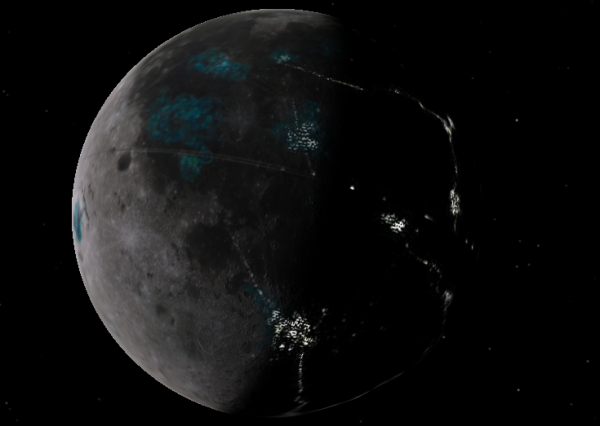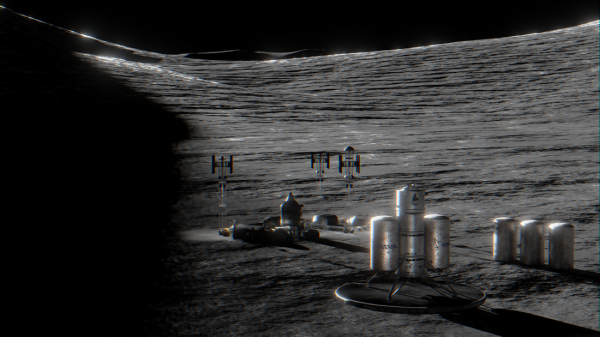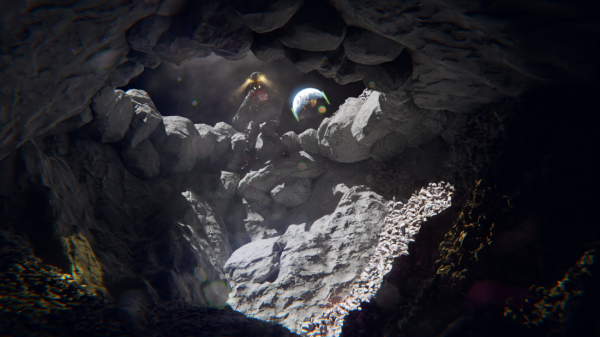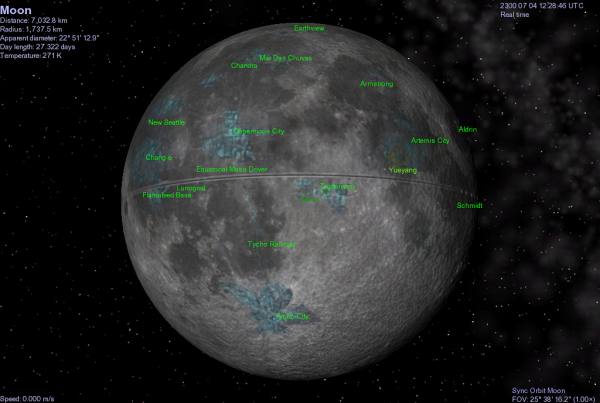BY LETTER
Luna
Galactography > Regions of Space > Inner Sphere
Galactography > Other Major Polities, Empires, and Meta-Empires > Solsys Organization
Galactography > Other Major Polities, Empires, and Meta-Empires > Solsys Organization
 Image from PortalHunter | |
| The Moon in the Interplanetary Age | |
 Image from Copyright Lilly Harper | |
| An early era Lunar station | |
Luna - Data Panel | |
| Type: | Selenian Subtype |
|---|---|
| Primary: | Earth |
| Diameter: | 3474 km |
| Gravity: | 0.166 gee |
| Orbital period: | 27.32166 days |
| Atmosphere: | In the Current Era much of Luna is paraterraformed under bluesky domes |
| Surface temperature: | Vacuum: -153C to 107C Paraterraformed zones: 12C to 27C |
| Administration: | Solsys Organisation member world |
| Population: | 1.063 billion sophonts (47% sophtwares, 12% lunar gravity tweaks, 12% vecs, 10% provolves, 10% near-baseline humans, 7% superiors, 2% vac-adapted lunar gravity tweaks) |
 Image from Lilly Harper | |
| A lava tube on Luna. These large hollow tubes were the site of some of the earliest permanent bases on the moon, since they afforded protection from space radiation, and in some cases they were relatively easy to pressurise. | |
Image from Steve Bowers | |
| The Earth and Moon in the Interplanetary Age, when the Earth still had a hi-tech civilisation on its surface. Since that time, of course, the Earth has been almost completely depopulated during the Great Expulsion; however Luna is still a thriving world, the most ancient of all human colonies. | |
Natural satellite of Earth. Home to permanent human settlement since the late Information Age, Luna (originally called the Moon, as it was the first one known by humankind) is a densely populated world, rich in history; the oldest Terragen colony on another celestial object. The first humans to set foot on the Moon were Neil Armstrong and Buzz Aldrin in 1969 CE (note - CE = the old Common Era calendar used on Earth). The new Lunar colonies adopted this date as their year zero, and the new dating system became known as the 'After Tranquility' (AT or a.t.) calendar.
The first steps towards building a permanent colony on Luna began in 68 AT, when remote-controlled 'telenaut' devices began constructing infrastructure there; no accommodation for humans was made at this stage. Human colonisation began in 91 AT, and even in 119 AT the largest settlement, Artemis, held only 200 people.
An extensive array of black-silicon or aluminium-mirror solar-power collectors powered these new colonies. Many of these panels were situated in a wide band around the equator to supply power to the equatorial mass driver; this was actually a series of launching ramps connected by a freight railroad network, which was set up to launch exports of iron, titanium, aluminium, oxygen and hi-tech goods into orbit. Many of the spacecraft that explored and colonised the worlds of the old Sol system were built partly or wholly from lunar materials.
Another major product of Lunar mining and construction in the early history of the colony was orbiting solar-power collector satellites; a large swarm at the Earth/Sun L1 Lagrange point delivered extra power to Luna, exported power to Earth and helped to propel spacecraft via an early boostbeam system.
 Image from Steve Bowers | |
| Colonies on the Nearside of Luna in 300 AT | |
Territories of Luna, 331 AT (2300 CE)
Nearside
-State of Selene, United States of America - Armstrong, Schmitt-Independent corporate territories - Aldrin, Aristarchus
-European Federation initiative - Tycho City
-Russian Republic dependent territories - Lunograd, Flamsteed
-Japanese Corporate Republic - Tsukuyomi
-International free ports - Artemis, the largest and oldest city; Copernicus (crater completely pressurised)
-International free agriculture development station - Earthview (Plato) (crater completely pressurised)
-Syndicate of Chinese Provinces lunar cantons - Yueyuan, Chang-e
-South Asian Compact colony - Chandra
-Brazilian colony - Mar das Chuvas (Mare Imbrium) (the Chandra and Imbrium colonies are centres for the processing of KREEP, a lunar rock containing uranium)
Farside
-Luna Silicon Initiative (Neumann dominated mining company)-Greater South Africa Republic colony - Mandela
-Syndicate of Chinese Provinces lunar canton - Heng-o
-Indonesian corporate development - Darkside (Planck Crater)
-McKendrick Moon Mining combine (vec dominated mining company) - Mendeleev Crater
-Russian Republic dependent territory - Korolev
Lunar society became a model of integration between nearbaseline, superior and AI culture, with many of the earliest superturing entities (such as Mycroft) becoming respected members of Lunar society.
Unfortunately the chaos of the Technocalypse caused both loss of life and degradation of artificial intelligence substrates. After the Great Expulsion, billions of refugees from Earth were accommodated in vast underground warrens in terrible conditions.
Luna became the new capital world of the Solar System when the Dark Age came to an end, though sometimes since it has lost the title to Mars or Ceres. The Lunar Calendar starting at 1 AT was widely adopted in the Solar System, and after the establishment of the First Federation this system became a widely used standard throughout the Terragen Sphere. As the Lunar Calendar has the same year length as the old Earth calendar, dates can be easily converted.
Luna in the Current Era
Image from Steve Bowers | |
| Luna in the Current Era; the Far Side from Earth is covered in worldhouses, while the Nearside is kept relatively pristine | |
Although Luna has never been fully terraformed, the idea was raised a few times during the following centuries, but was vehemently vetoed by the Lunarians, who described it as terranist environmental imperialism. There are extensive bluesky domes, as well as a number of underground settlements. Tourism in the non-paraterraformed areas includes observation domes and the scenic maglev railways. On the side of Luna that faces Earth, most signs of civilisation are camoflaged, in order to make the Moon appear as untouched as possible as seen from GAIA's Earth.
Major Lunarian cities include Artemis (where one can find a nanoreplica of the original first moonbase), Lunograd, Tycho City (an important cultural center - the Tycho Museum of History is a popular tourist stop), Earthview, Armstrong, Copernicus (with its quaint First Federation period architecture), an array of large surface bluesky parks and recreation areas, Aldrin, Schmitt, Tsukuyomi, Imbrium, Serenatis, and Darkside.
Back to Solsys
Related Articles
Appears in Topics
Development Notes
Text by Anders Sandberg
Additional Material by Steve Bowers
Initially published on 17 October 2008.
Additional Material by Steve Bowers
Initially published on 17 October 2008.
Additional Information
Image 'Early Luna Station' copyright by Lilly Harper used with permission. Please contact her for conditions of re-use at https://beaconsinthedark.wordpress.com/.






